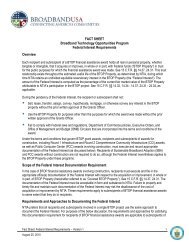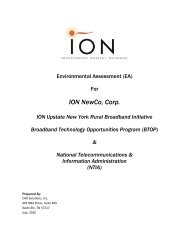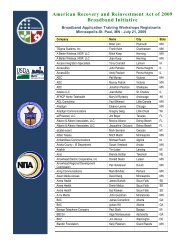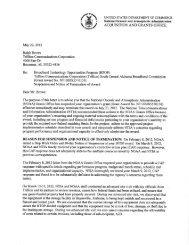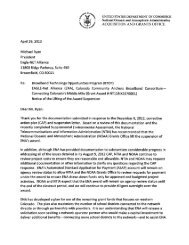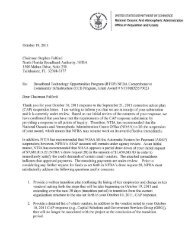Grant Guidelines for the RECOVERY ACT BROADBAND ...
Grant Guidelines for the RECOVERY ACT BROADBAND ...
Grant Guidelines for the RECOVERY ACT BROADBAND ...
You also want an ePaper? Increase the reach of your titles
YUMPU automatically turns print PDFs into web optimized ePapers that Google loves.
include interoffice transport, backhaul, Internet connectivity, and special access. Because RUS<br />
and NTIA recognize that applicants may need to build middle mile infrastructure as part of a last<br />
mile deployment, <strong>the</strong>se categorizations are not expected to be exclusive, and applicants are<br />
asked to choose whichever of <strong>the</strong>se service types, last mile or middle mile, <strong>the</strong>ir project will<br />
predominantly provide. For a BTOP Broadband Infrastructure project or BIP middle mile<br />
project, this determination is sufficient to select <strong>the</strong> correct project category.<br />
For example, where an applicant proposes to deploy backhaul <strong>for</strong> <strong>the</strong> express purpose of<br />
supporting a last mile deployment that is part of <strong>the</strong> same proposal, <strong>the</strong> applicant should<br />
characterize <strong>the</strong> project as predominantly a last mile project. If, by contrast, <strong>the</strong> last mile<br />
facilities deployed in <strong>the</strong> project are just one of many last mile networks that <strong>the</strong> backhaul<br />
facilities are expected to serve, <strong>the</strong> project would likely be better characterized as a middle mile<br />
project. Applicants proposing substantial last mile and middle mile components and planning<br />
to offer services independently on each component who are unable to designate <strong>the</strong>ir proposal<br />
as predominantly last mile or middle mile are advised to file separate applications <strong>for</strong> <strong>the</strong> last<br />
mile and middle mile components and to discuss <strong>the</strong> relation between components in <strong>the</strong><br />
applications.<br />
While <strong>the</strong> infrastructure project categories described above apply most clearly to projects<br />
designed to facilitate fixed or mobile consumer broadband, RUS and NTIA anticipate that some<br />
applicants will take a different approach—<strong>for</strong> example creating a regional fiber ring to connect<br />
schools, hospitals, or o<strong>the</strong>r community anchor institutions. RUS and NTIA welcome such<br />
proposals. A project of this nature should be characterized as a middle mile project as it is<br />
essentially a point‐to‐point network connecting a relatively small number of facilities (as<br />
distinguished from a last mile project which may provide access to community anchor<br />
institutions in additional all of <strong>the</strong> homes and businesses in <strong>the</strong> funded service area).<br />
Additionally, each point on <strong>the</strong> network may serve as a potential point of interconnection from<br />
which independent parties can construct a last mile network.<br />
Unserved/Underserved Requirements<br />
Infrastructure applicants should bear in mind that all infrastructure projects are required to<br />
provide service to unserved or underserved areas. For BTOP last mile projects, <strong>the</strong> entire<br />
proposed funded service area must be unserved or underserved. For BTOP middle mile<br />
projects, at least one interconnection point must terminate in an unserved or underserved<br />
area.<br />
‐ 18 ‐ 7/10/2009




